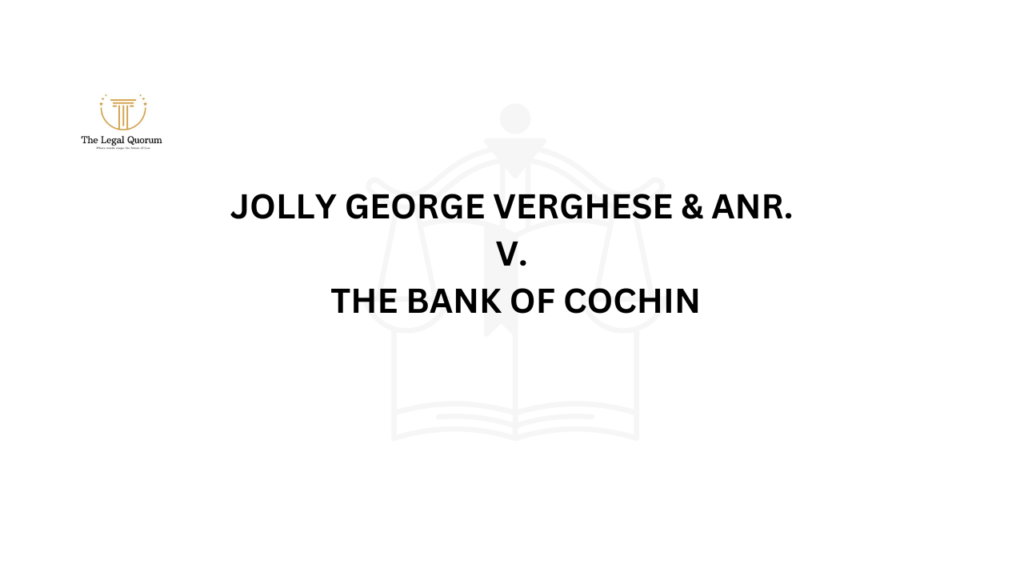Published On: November 19th 2025
Authored By: Sri Durga.O
Government law college Tirunelveli
Citation: (2013) 6 S.C.C. 1 (India).
Court: Supreme Court of India
Bench: Justice Aftab Alam and Justice Ranjana Prakash Desai
Date of Judgment: April 1, 2013
Relevant Statutes and Key Provisions
- The Patents Act, 1970 – particularly Section 3(d).
- Agreement on Trade-Related Aspects of Intellectual Property Rights (TRIPS), 1995.
- Constitution of India – Articles 14, 19, 21 (raised indirectly).
Brief Facts
Novartis AG, a Swiss pharmaceutical company, developed Imatinib Mesylate, marketed under the brand name Glivec, for the treatment of chronic myeloid leukemia (CML) and other cancers..
In 1998, Novartis filed a patent application in India for the beta crystalline form of Imatinib Mesylate under the “mailbox” system created to comply with TRIPS.This allowed patent applications to be held until India amended its law in 2005 to allow product patents. In 2006, the Madras Patent Office rejected the application, holding that the beta crystalline form lacked novelty and inventive step. On appeal, the IPAB recognized novelty but concluded that the application failed under Section 3(d) because Novartis had not shown enhanced efficacy.
Novartis then approached the Supreme Court, also questioning whether Section 3(d) was constitutional and TRIPS-compliant.
Issues Involved
- Whether the beta crystalline form of Imatinib Mesylate was patentable under Indian law.
- Whether improved properties like stability and bioavailability amounted to “enhanced efficacy” under Section 3(d).
- Whether Section 3(d) of the Patents Act was unconstitutional or inconsistent with India’s obligations under TRIPS.
Petitioner’s Arguments (Novartis)
- Patentability of the Invention
Novartis asserted that the beta crystalline form of Imatinib Mesylate was not merely a trivial modification but a genuine invention. According to Novartis, it was novel, non-obvious, and satisfied the statutory criteria for patentability. The company argued that the crystalline form had unique properties that distinguished it from the known free base and other salts of Imatinib Mesylate.
- Enhanced Efficacy through Improved Properties
Novartis maintained that the beta crystalline form showed improved physico-chemical properties: it was more stable, less hygroscopic, and had better flow properties. Most importantly, it demonstrated 30% increased bioavailability compared to the non-crystalline form. Novartis argued that “efficacy” under Section 3(d) should be interpreted broadly to include such improvements because higher bioavailability makes more of the drug available in the bloodstream, thereby contributing to better therapeutic outcomes.
- Compliance with International Standards (TRIPS Argument)
Novartis contended that Section 3(d) was inconsistent with India’s obligations under the TRIPS Agreement. TRIPS requires patents to be granted for inventions that are novel, involve an inventive step, and are capable of industrial application. It does not impose the additional hurdle of proving enhanced therapeutic efficacy.By introducing Section 3(d), India had allegedly created a fourth requirement for patentability, which Novartis argued was beyond the scope of TRIPS and discriminatory towards pharmaceutical inventions.
- Constitutional Challenge
Novartis argued that Section 3(d) was arbitrary and vague, violating Article 14 of the Constitution (Right to Equality). The term “enhanced efficacy” was, according to Novartis, undefined and uncertain, giving patent authorities excessive discretion. This uncertainty, they argued, created legal unpredictability, discouraging pharmaceutical innovation and investment in India.
- Innovation and Public Policy Considerations
Novartis warned that denying patents on incremental innovations would discourage investment in research and development. Pharmaceutical companies often improve existing drugs to enhance patient safety, stability, and dosage efficiency. Such innovations, if unprotected, would not be pursued. Denying the patent for Glivec, they argued, sent a negative signal to global innovators about India’s respect for intellectual property.
Respondents’ Arguments (Union of India & Others)
- Failure to Show Therapeutic Efficacy
The respondents emphasized that therapeutic efficacy was the only relevant standard under Section 3(d). Improved stability or bioavailability, unless proven to enhance actual treatment outcomes, was insufficient. Novartis had not submitted any clinical data demonstrating that the beta crystalline form was more effective in curing or treating cancer than existing forms of Imatinib Mesylate.
- Public Health and Access to Medicines
Section 3(d) was a conscious safeguard introduced by Parliament to prevent evergreening, ensuring that minor modifications could not be used to unjustifiably extend patent monopolies. Granting Novartis’s patent would have blocked generic manufacturers from producing affordable versions of Imatinib Mesylate, severely impacting access for patients in India and other developing countries. NGOs such as the Cancer Patients Aid Association argued that Glivec’s patented price (around INR 1,20,000 per month) was unaffordable, while generics were available at INR 8,000–10,000, saving countless lives.
- Constitutional Validity of Section 3(d)
The provision was neither vague nor arbitrary. Its intent and meaning were clear: to ensure that patents are granted only for genuine innovations that enhance therapeutic outcomes. Parliament had deliberately crafted Section 3(d) after extensive debate, balancing the requirements of TRIPS with India’s socio-economic realities.
- TRIPS Compliance
The respondents pointed out that TRIPS does not define “inventive step” or “efficacy”, leaving WTO member states free to adopt standards suited to their circumstances. Section 3(d) was therefore a lawful flexibility within TRIPS, consistent with the Doha Declaration (2001), which reaffirmed members’ rights to protect public health.
- Safeguarding India’s Generic Industry
India’s generic drug industry, often described as the “pharmacy of the developing world,” supplied affordable medicines not only within India but also to many developing countries. Granting Novartis’s patent would set a precedent allowing evergreening of blockbuster drugs, threatening this role and restricting access to life-saving treatment worldwide.
- Policy Justification
Respondents stressed that pharmaceutical innovation often focuses on extending market monopolies rather than genuine therapeutic advances. Without safeguards like Section 3(d), India risked becoming dependent on expensive imported medicines, undermining its public health system.
Judgment
The Supreme Court, speaking through Justices Aftab Alam and Ranjana Prakash Desai, dismissed Novartis’s appeal and refused to grant a patent for the beta crystalline form of Imatinib Mesylate. The reasoning of the Court can be broken down into several key parts:
Novelty and Inventive Step
The Court accepted that the beta crystalline form could be considered new and inventive when compared to the earlier known forms of Imatinib. However, it pointed out that under Indian law, especially because of Section 3(d), showing novelty and inventive step alone was not enough. When a company seeks a patent on a new form of a known drug, it must also prove that this new form gives patients a real improvement in treatment.
Meaning of “Efficacy” under Section 3(d)
The judges carefully considered what the law meant by “enhanced efficacy.” They said that in the context of medicines, efficacy could not just mean better chemical properties or easier storage. Instead, it had to mean therapeutic efficacy—in simple terms, whether the drug actually works better in curing or treating disease. Improvements like stability or flow properties may be helpful for manufacturers, but they do not matter for patients unless they make the medicine more effective.
Bioavailability Argument
Novartis relied on the fact that the crystalline form had about 30% better bioavailability, which means that more of the drug enters the bloodstream. The Court did not dispute this. However, it stressed that just because more of the drug enters the blood does not automatically prove that patients get better results. For example, without clinical evidence to show that patients responded better to the crystalline form than to the earlier version, Novartis could not prove enhanced therapeutic efficacy. The Court noted that Novartis had not provided such evidence.
Applying Section 3(d)
Looking at the facts, the Court found that Novartis’s improvements were limited to physical and chemical advantages. These may be scientifically useful, but they did not show that the drug worked better in practice. Since Section 3(d) requires proof of real therapeutic benefits, Novartis’s application failed this legal test.
Constitutionality of Section 3(d)
Novartis argued that Section 3(d) was vague and unconstitutional. The Court rejected this argument. It explained that Parliament had deliberately included Section 3(d) to stop the practice of evergreening, where companies try to extend their monopolies by making minor changes to old drugs. The judges found that the law was clear enough and gave sufficient guidance to applicants and patent examiners.
TRIPS Compliance
Novartis also argued that Section 3(d) went against India’s obligations under the TRIPS Agreement. The Court disagreed, stating that TRIPS only sets minimum standards and allows countries to design their own patent rules. Section 3(d) was therefore within India’s rights, especially since international agreements like the Doha Declaration also recognize the importance of public health.
Policy Concerns
The Court also addressed the wider policy issues. It emphasized that the law does not block genuine pharmaceutical innovation. If a company can prove that a new form of a known drug actually works better for patients, a patent can still be granted. But if only small, cosmetic changes are made, patents cannot be used to block affordable generic medicines. This balance was essential for India, where millions depend on low-cost drugs.
Outcome
In the end, the Court dismissed Novartis’s appeal. The company’s patent was not granted, and generic manufacturers were free to continue producing affordable versions of Imatinib Mesylate. The Court made it clear that while innovation is welcome, patent law in India would protect only those inventions that provide genuine medical benefits.
Ratio Decidendi
- For pharmaceuticals, the term “efficacy” in Section 3(d) must be interpreted as therapeutic efficacy.
- Improvements in physical or chemical properties (e.g., stability, bioavailability) are not sufficient unless linked to clinical benefit.
- Section 3(d) is constitutional and consistent with India’s obligations under TRIPS.
Obiter Dicta
Incremental innovations are not barred outright. If future applicants can demonstrate that modifications result in genuine therapeutic benefits, such patents may be granted.
Section 3(d) should not be seen as hostile to innovation, but as a filter against frivolous patents.
Final Decision
The Supreme Court rejected Novartis’s patent claim. Generic manufacturers in India were therefore permitted to continue producing Imatinib Mesylate, ensuring affordable treatment for cancer patients.
Impact and Significance
- Curbing Evergreening: The decision firmly established Section 3(d) as a safeguard against evergreening. Pharmaceutical companies could no longer rely on minor modifications to extend patent monopolies.
- Public Health Priority: The ruling ensured affordable access to Imatinib Mesylate. While Novartis priced Glivec at about INR 1,20,000 per month, Indian generics cost only INR 8,000–10,000, drastically increasing accessibility for patients.
- Strengthening India’s Generic Industry: The judgment reaffirmed India’s role as the “pharmacy of the developing world,” allowing the continued production of low-cost generic medicines for both domestic use and export to developing countries.
- Global Reactions: The judgment was praised by NGOs, public health advocates, and developing nations as a victory for access to medicines. Multinational pharmaceutical companies criticized it as undermining incentives for innovation.
- Precedent Value: The interpretation of Section 3(d) provided by the Supreme Court has served as binding precedent in subsequent cases, influencing future patent disputes and international discussions on balancing intellectual property and public health.
- Policy Impact: The decision strengthened India’s position in global trade negotiations and reaffirmed the constitutional commitment to protect the right to health.




